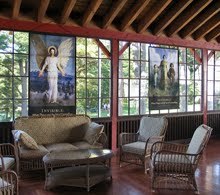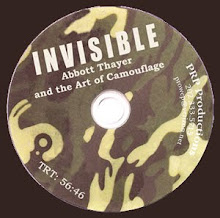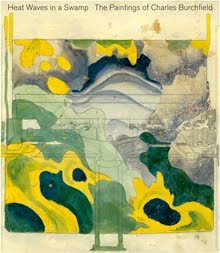- and one can see the results of commitment to ideals, not only to the artist's 'ideal beauty' but also to humanitarian......issues, to the struggle against mental illness, and the struggle for visionary leadership, as well as the difficulties and deep despair associated with the invention of camouflage.
GOALS -- Students will:
• View the movie, Invisible: Abbott Thayer and the Art of Camouflage and complete Pre-Viewing and Post-Viewing Questions
• Discuss the concepts in the movie and related research and art activities
• Understand the historical perspective and context of Thayer’s work and life
• Understand the links between Thayer’s work and other artists and the Dublin Art Colony
• Gain an appreciation of the demands of an artist’s commitment to art
• Research and value the student’s local and regional environment
• Create original, creative work based on an understanding of Thayer’s influences, themes and process
Abbott Thayer’s themes include symbolic portraits of young women and family groups, Mount Monadnock and other landscapes, and animals in their natural surroundings as examples of concealing coloration, practical observations of nature and artistic insight. Thayer’s work evolved from traditional paintings, portraits and full views of figures in the style of the Rennaisance as studied at L’Ecole des Beaux-Arts in Paris -- to more spontaneous, visible, even abstract brush strokes in landscape and portraits, and then to careful studies of nature and animals in the realm of camouflage.
Through the study of Thayer’s work and inspirations and an exploration of the local environment of Monadnock, students will discuss related ideas and create original, individual solutions to specific questions and assignments.
NATIONAL STANDARDS FOR VISUAL ARTS EDUCATION 9-12
The lesson plans included in this syllabus address all six National Content Standards:
1. Understanding and applying media, techniques, and processes
2. Using knowledge of structures and functions
3. Choosing and evaluating a range of subject matter, symbols and ideas
4. Understanding the visual arts in relation to history and cultures
5. Reflecting upon and assessing the characteristics and merits of their work and the work of others
6. Making connections between visual arts and other disciplines
The National Content and Achievement Standards can be found at the National Art Education Association.
THEMES
Personal Environment and Experiences, Local Natural World, Composition, Use of Color, Personal Style, Symbolic Imagery, Social Impact of Art, Military Strategy of Camouflage
Local Themes: Conservation, Preservation of Mount Monadnock, Dublin Art Colony, Monadnock Art Colony, Joseph Lindon Smith, Richard S. Meryman, Alexander James, Geroge de Forest Brush and other Dublin Artists
Recommended Reading:
Abbott Thayer in the Spell of Monadnock, by Richard Meryman, pages 195-205 in Where the Mountain Stands Alone, Stories of Place in the Monadnock Region, Howard Mansfield, Editor, copyright 2006 by the Monadnock Institute of Nature, Place and Culture at Franklin Pierce College, published by University Press of New England, www.upne.com.
More articles available at the archives of the Dublin Historical Society, Keene Libraries and online links.
Supplemental research ideas: Influences on Abbott Thayer’s Artistic Development: Likeness with Cezanne, influence of abstract expressionists and modernism






